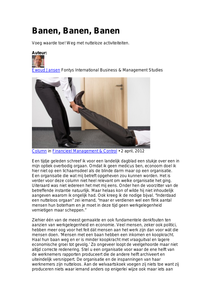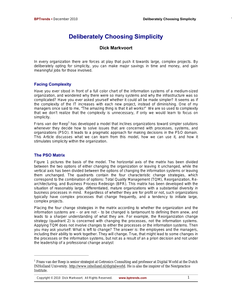Ongeveer een derde van onze nationale energieconsumptie wordt gebruikt in gebouwen voor verwarming, koeling, verlichting en elektrische apparatuur. Milieuoverwegingen, voorzieningszekerheid en kosten maken dat wij slim met de energievoorziening in de gebouwde omgeving om moeten gaan. Maar alle slimheid, innovatie en creativiteit ten spijt is het gasverbruik van woningen gebouwd in 2010 niet lager dan van woningen gebouwd in 1995, zijn de woningen niet gezonder geworden, gebruikt de gebouwde omgeving ook nog ieder jaar meer elektriciteit en zijn er nauwelijks duurzame installaties die naar behoren werken. Wat leren wij daarvan? Hoe zorgen wij ervoor dat duurzaamheid meer dan een losse kreet wordt en onze hele energieketen echt duurzaam wordt? Naast innovatie en creativiteit zijn kennis en vakmanschap belangrijk. Systemen modelleren en simuleren, en het gebruiken van virtual environments om grip te krijgen op het ontwerp, regeling en onderhoud van complexe binnenklimaatinstallaties en energie-installaties zullen hierbij in de toekomst een steeds belangrijkere rol gaan spelen.
DOCUMENT

Er wordt veel werk gedaan waar we niets aan hebben. De bezem moet er dringend door.
DOCUMENT

Begin 2006 betrok Facilicom Services Group haar nieuwe hoofdkantoor in Schiedam. Het gebouw was ontwikkeld vanuit een totaalvisie op toegepast duurzaam ondernemen en geïntegreerd facility management. In een gesprek met Paul Janssen, stafdirecteur marketing bij Facilicom, evalueert FMI het eerste lustrum van het schoolvoorbeeld van de facilitaire kantooromgeving.
DOCUMENT

The book is about finance and accounting, subjects widely discussed in many other books. What sets this book apart from most others is that it discusses all the basic aspects of finance and accounting in one single textbook. Three areas of interest are discussed: Financial Management; Management Accounting; Financial Accounting. Typically, these three subjects are treated separately as individual topics. They are closely related, however, since they all deal with the many financial issues facing business organizations. All topics are discussed at an introductory level, which makes this book very useful for introductory courses on finance & accounting. This book will be of interest to students preparing for a more in depth study of the topics later in their curriculum as well as for those who need a basic yet comprehensive introduction to the subject. The book's intended audience is students following bachelor programs of business science. However it may also be suitable for master program students, especially for those students whose focus is more on practical relevance than on academic theory. The author has many years of experience in teaching students from many different countries and backgrounds. This experience is reflected in the no nonsense approach and the many examples throughout the text.
DOCUMENT
Na een jaar van literatuurstudie, gesprekken en (participerende) observaties over de waarde van sport- en beweegdeelname voor kwetsbare doelgroepen, blijkt dat het verschil vaak in een klein hoekje zit. Voor mensen in kwetsbare posities (zoals daklozen of ex-gedetineerden) blijkt het stappen in de ‘rol’ van sporter bijvoorbeeld al veel te kunnen doen voor het zelfvertrouwen. De deelname aan sport- en beweegactiviteiten zorgt er echter niet alleen voor dat je even niet aan je problemen denkt. Ook is er sprake van een zogenaamde normaliserende werking: het idee dat je even ‘normaal’ mee kunt doen in de maatschappij. Het idee achter veel sportprojecten is dat dit positievere zelfbeeld tevens kansen biedt om bijvoorbeeld weer met (vrijwilligers)werk te beginnen. Deze en meer relatief kleine effecten kunnen een groot verschil maken, zo blijkt uit de eerste fase van het (Raak) onderzoeksproject 'Sport voor Participatie'.
LINK
De wereldwijde energievraag is enorm en blijft stijgen, maar fossiele energiebronnen, waarvan wij nog voor meer dan 80% afhankelijk zijn raken op, voorzieningszekerheid en onafhankelijkheid worden steeds moeilijker te garanderen, en de milieugevolgen van conventionele energieconversiesystemen zijn niet meer aanvaardbaar. Bijna 40% van de Nederlandse energieconsumptie komt voort uit energiegebruik om gebouwen en hun directe omgeving te voorzien van warmte, koude en elektriciteit1. De Europese Unie heeft aangegeven dat in 2020 nieuwbouw energieneutraal moet zijn. In 2050 zou de hele gebouwde omgeving energie neutraal moeten zijn en de CO2-uitstoot zou gereduceerd moeten zijn met 80-95% (t.o.v. 1990). Daarnaast heeft de Nederlandse overheid als doelstelling voor 2020 16% minder CO2-uitstoot, 20% energiebesparing en moet 14% van de energiebehoefte afkomstig zijn van hernieuwbare bronnen.
DOCUMENT

Praktische toepassingen van FinTech (FinTech=de digitale transformatie van, met name, de financieel-zakelijke dienstverlening)
LINK
International education is a relatively new field and until recently, there was no formal education to prepare practitioners. This means that people working in international education are a colourful and diverse group, coming from a wide range of disciplines, which definitely adds to the attraction of the field. I call international education a field rather than a discipline since it is composed of a variety of established disciplines, such as languages, educational sciences, psychology, business, anthropology, history and even, in my case, classical archaeology. For this lecture, I have chosen to return to my original discipline and discuss global learning as the stages of an archaeological excavation. Cutting though the subsequent layers represents a history of international education but also my own professional history. By digging deeper down, layer after layer, I hope to uncover the essence of global learning in order to make its benefits available for all our students. This lecture consists of four sections. In the first section, I want to go back to the time when archaeology was a new discipline and see what we can learn from the research conducted at that time. In the second section I will reveal the layers of internationalisation and global learning until we come to the layer that we are currently exploring. In the third section, I will look at some of the factors and trends that will have an impact on global learning in the years to come. This shows that circumstances are quite different from when the excavation started and that global education is therefore dynamic. Finally, I will discuss what research the Research Group Global Learning will conduct, how and with whom, in the coming years.
DOCUMENT

This Article presents the PSO matrix as a tool for making choices in change projects – choices for simplicity or for complexity. A good process structure is essential for a simple organization, but it is the employees and the managers who are expected to take the lead in the changes and the improvement proposals. The PSO matrix is a useful and usable instrument that promotes simplicity and respects the intelligence that is already present in the organization, particularly that of the ordinary employees. The approach leads to drastic savings. Do as much nothing as possible.
DOCUMENT
